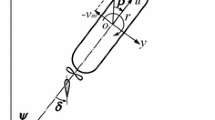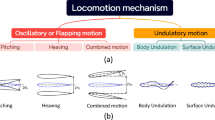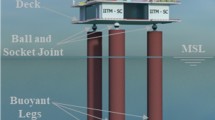Abstract
An equivalent single rudder (ESR) model is presented for maneuvering simulations of twin-propeller and twin-rudder ships within the framework of the maneuvering modeling group (MMG) method Yasukawa (J Marine Sci Technol 20:37–52, 2015). It eliminates the complexity of a mathematical model by treating a port and starboard rudders as a single rudder located at the center of the ship hull. Specifically, an expression for the rudder force is presented using the ESR model. As examples, the results of captive model tests for a twin-screw ferry in deep and shallow water and the analysis results are presented, and maneuvering simulations are conducted using the hydrodynamic force coefficients obtained from the analysis. The simulation results of turning and zig–zag maneuvers agree with the results of free-running model tests, in regard to practical application. The maneuvering simulation method using the ESR model is validated for twin-propeller and twin-rudder ships in deep and shallow water.
























Similar content being viewed by others
References
Lee S, Fujino M, Fukazawa T (1988) A study on the manoeuvring mathematical model for a twin-propeller twin-rudder ship. J Soc Naval Archit Japan 163:109–118 ((in Japanese))
Yoshimura Y, Sakurai H (1989) Mathematical model for the manoeuvring ship motion in shallow water (3rd report) -manoeuvrability of a twin-propeller twin rudder ship-. J Kansai Soc Naval Archit 211:115–126 ((in Japanese))
Kobayashi H, Ishibashi A, Hasegawa Y, Nakanishi Y (1992) A study on the maneuverability of twin-propeller twin-rudder ship. J Japan Inst Navig 86:205–213 ((in Japanese))
Yasukawa H, Yoshimura Y (2015) Introduction of MMG standard method for ship maneuvering prediction. J Marine Sci Technol 20:37–52
Kim Y, Kim S, Kim H, Lee S, Yu B (2007) Prediction of the maneuverability of a large container ship with twin propeller and twin rudders. J Marine Sci Technol 12:130–138
Dash AK, Chandran PP, Khan MK, Nagarajan V, Sha OP (2016) Roll-inducted bifurcation in ship maneuvering under model uncertainty. J Marine Sci Technol 21:689–708
Araki M, Sadat-Hosseini H, Sanada Y, Tanimoto K, Umeda N, Stern F (2012) Estimating maneuvering coefficients using system identification methods with experimental, system-based and CFD free-running trial data. Ocean Eng 51:63–84
Sukas OF, Kinaci OK, Bal S (2019) System-based prediction of maneuvering performance of twin-propeller and twin-rudder ship using a modular mathematical model. Appl Ocean Res 84:145–162
Crane CL (1979) Manoeuvring trials of a 278,000-DWT tanker in shallow and deep waters. Trans SNAME 87:251–283
Fujino M (1968) Experimental studies on ship manoeuvrability in restricted water. Part I Int Shipbuild Progress 15(168):279–301
Fujino M, Ishiguro T (1984) A study of the mathematical model describing manoeuvring motions in shallow water: shallow water effects on rudder-effectiveness parameters. J Soc Naval Archit Japan 156:180–192 (in Japanese)
Kijima K, Murakami M, Katsuno T, Nakiri Y (1984) A study on the ship manoeuvring characteristics in shallow water. Trans West Japan Soc Naval Archit 69:111–122 ((in Japanese))
Yoshimura Y (1986) Mathematical model for the manoeuvring ship motion in shallow water. J Kansai Soc Naval Archit 200:41–51 ((in Japanese))
Taimuri G, Matusiak J, Mikkola T, Kujala P, Hirdaris S (2020) A 6-DoF maneuvering model for the rapid estimation of hydrodynamic actions in deep and shallow waters, Ocean Engineering 218, Published online
Carrica PM, Mofidi A, Eloot K, Delefortrie G (2016) Direct simulation and experimental study of zigzag maneuver of KCS in shallow water. Ocean Eng 112:117–133
Balagopalan A, Krishnankutty P (2021) Manoeuvring prediction of a container ship in shallow water using numerical planar motion mechanism. Published online, Ship Technology Research
Yasukawa H, Hirata N, Tanaka S, Ito S (2011) Hydrodynamic force characteristics on maneuvering of a twin-propeller twin-rudder ship with bow thruster. J Japan Inst Navig 125:209–217 ((in Japanese))
Yasukawa H, Sakuno R, Yoshimura Y (2019) Practical maneuvering simulation method of ships considering the roll-coupling effect. J Marine Sci Technol 24:1280–1290
Fujii H, Tuda T (1961) Experimental researches on rudder performance (2). J Soc Naval Archit Japan 110:31–42 ((in Japanese))
Hamamoto M, Kim Y-S (1993) A new coordinate system and equations describing the maneuvering motion of a ship in waves. J Soc Naval Archit Japan 173:209–220 ((in Japanese))
Matsuda A, Hashimoto H, Terada D, Taniguchi Y (2016) Validation of free running model experiments in heavy seas, Proc. 3rd International Conference on Violent Flows, Osaka, Japan
Hasnan MAA, Yasukawa H, Hirata N, Terada D, Matsuda A (2020) Study of ship turning in irregular waves. J Marine Sci Technol 25:1024–1043
Yasukawa H, Kawamura S, Tanaka S, Sano M (2009) Evalution of ship-bank and ship-ship interaction forces Using a 3D panel method, International Conference on Ship Manoeuvring in Shallow and Confined Water: Bank Effects, Antwerp, Belgium, 127–133
Acknowledgements
This study was supported by Fundamental Research Developing Association for Shipbuilding and Offshore (REDAS). We would like to thank Mr. H. Ibaragi of the Kyushu University for his support provided for the captive model tests in shallow water. We would also like to thank Mr. T. Suzuki, Mr. K. Enui, Mr. T. Yamashita, and Mr. Y. Iida for their assistance in conducting the tank tests.
Author information
Authors and Affiliations
Corresponding author
About this article
Cite this article
Okuda, R., Yasukawa, H., Sano, M. et al. Maneuvering simulations of twin-propeller and twin-rudder ship in shallow water using equivalent single rudder model. J Mar Sci Technol 27, 948–970 (2022). https://doi.org/10.1007/s00773-022-00881-x
Received:
Accepted:
Published:
Issue Date:
DOI: https://doi.org/10.1007/s00773-022-00881-x




